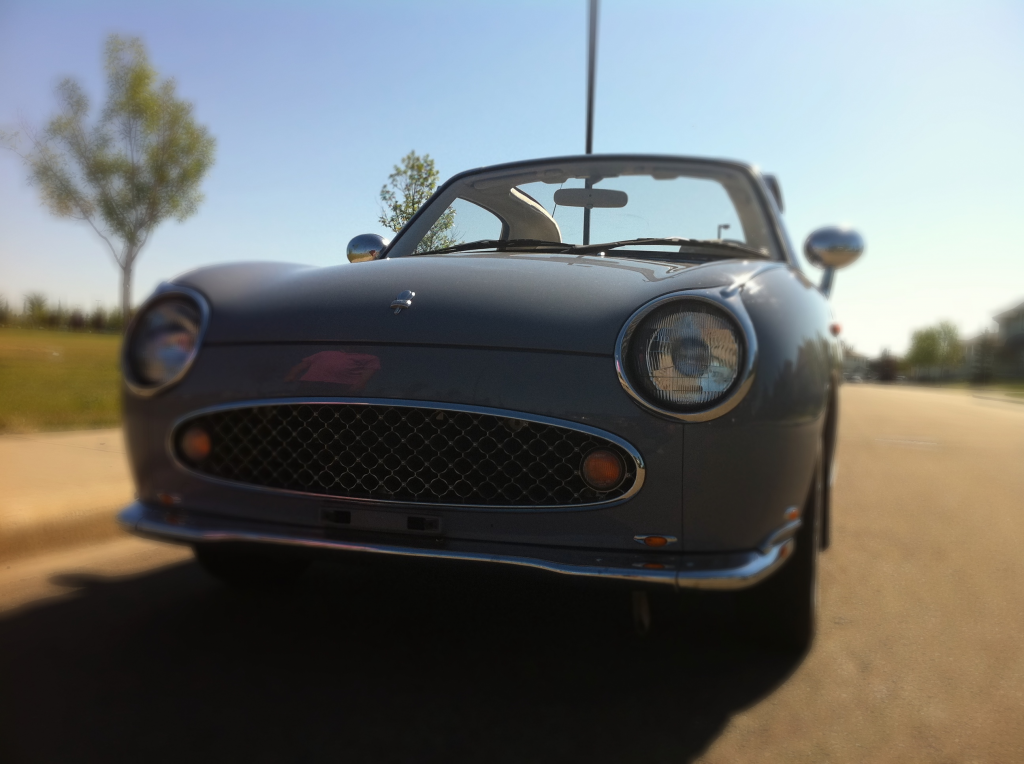A particular genus of catsharks, a specific type of chain used in jewelry, and the central character in Pierre Beaumarchais’ The Barber of Seville have scarcely little in common. Just one word, really. It’s a word with an undeniable lightness, even playfulness, and acknowledged musical connotation. It’s a word that demands to be sung rather than spoken, with a smattering of vibrato if at all possible. It’s a word that paints pictures of Tuscan sunsets slipping into the horizon’s warm embrace.
Fiiiiiiigarrooooo.
It’s also, by some accounts, a car. Designed by Shoji Takahashi and Naoki Saiki, and sold by lottery from 1989-1991, the Nissan Figaro is a retrotastic salute to simplicity with just a dash of creature comfort. Styled to resemble compact coupes from the 1950’s and 60’s (Mini, Renault 4, Citroen 2CV and Austin A40, as legend has it), the Figaro takes classic proportions and adds electric windows, a fuel-efficient port-injected engine, hard-blowing A/C, and Japanese reliability to the formula.
No sooner was the Figaro (and retro-sibling Pao, built on the same Nissan Micra platform) introduced then a frenzy exploded across the pages of Nissan’s ordering books. The original plan to produce 8,000 units of each design soon expanded to 20,000 and it still wasn’t enough. Keep in mind that these were only sold in the Japanese Domestic Market initially. The car pictured here was purchased by its owner scarcely a month ago.
In a perfect case study of the usefulness of social media, shortly after we tweeted this picture, the owner saw it and laid claim to our find. After a few messages back and forth, we eventually agreed on a time and place to meet. Amazingly, we were offered the keys right from the get-go!
Once settled comfortably in the diminutive and well-kept convertible, the defining characteristic of the Figaro driving experience becomes immediately clear: it’s right hand drive. I expected this to rear its butt-ugly head when shoulder checking and turning left, but it turns out that going straight is the biggest challenge. Trying not to drift into the left lane or directly into a concrete barrier required conscious effort. The 1800lb car wouldn’t fare so well with the vulturine trucks in this part of the world.
The bakelite steering wheel that navigates the USS Adorable almost evaporates into the driver’s hands. It’s thin frame and stubbled rim require only your fingertips to direct the front wheels.
The 1.0L turbo engine is unbelievably smooth, whirring like an increasingly contented kitten at every added rev. It was refined, silky, and used its 75 horsepower to motivate the meager mass as fast as you’d ever need in a city. Never mind “need”, 75hp towing 1800lbs is as much as you’d ever want around town.
The 3-speed automatic transmission made acclimatizing to RHD that much easier, but three cogs can only cover so much of the power band. Eventually, the engine runs out of gears and just has to climb the revs higher and higher. The noise is far from unpleasant, this is a smooth unit after all, but it does dominate the acoustic experience above 60kph. A 5-speed manual was available from the factory, but of the 20,000 Figaros produced, only a small fraction had the do-it-yourselfer installed.
In fact, 60kph is about as fast as I was inclined to push the Figaro. And that’s not in the corners marked 15kph by a big yellow diamond, that’s in a straight line. Far from egging me on to test its (undoubtedly) low limits of grip, it implores the driver to tread gingerly over the road’s surface around 40-50kph. This humble respect for the speed limits ensures that police will only ever pull you over to ask what on God’s Green Earth you’re driving. You can charmingly flip up your Ray Bans and informs the Officer that you’re piloting one of the rarest convertibles in the country. With only an estimated 100 Figaros in all of Canada, only two of which are in Edmonton, the Pike Factory product is hen’s teeth to the power of fifty.
The detailing, from bow to stern, is beautifully crafted the way only Japanese cars are. The chromed toggles still look factory fresh and the hinges that release the soft-top feel as if they’ll effortlessly latch into place long after the rest of the vehicle has succumbed to Father Time. The graceful branding touches somehow don’t seem cliché, but rather bespoke: like the “Figaro” branded mudflaps and “Figaro” branded carpets.
The whole experience was absolutely scintillating. The charming Figaro has soul in spades and charm to spare. And unlike most of the made-up names adorning cars these days (eg. Venza), the lightness and playfulness implied by this lovely treat really does say it all.
Fiiiiiiigarrooooo.
Thank you to David Harrigan (@onedery) for generously allowing us to get behind the wheel of his Figaro. It was truly an honour.


















